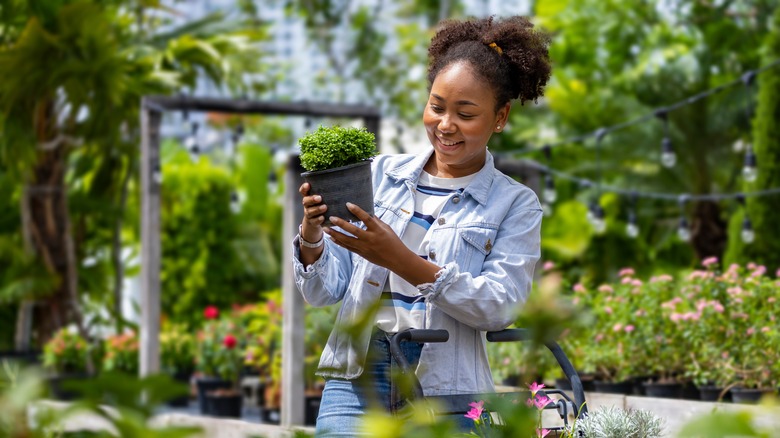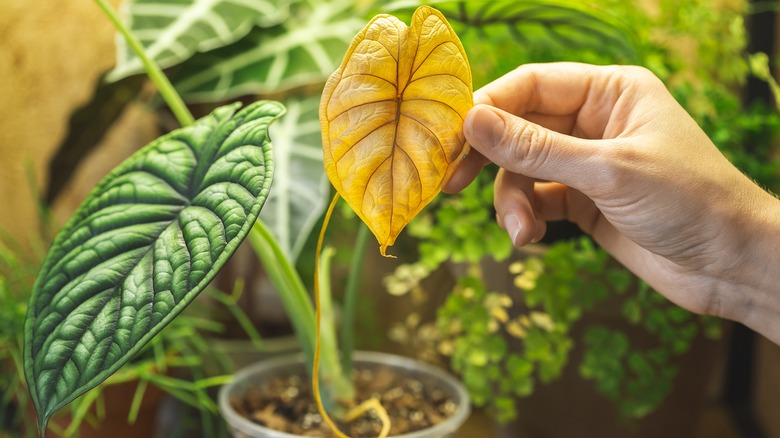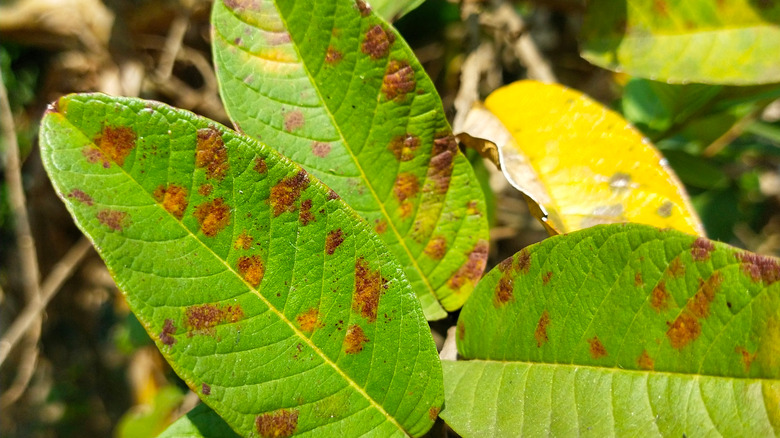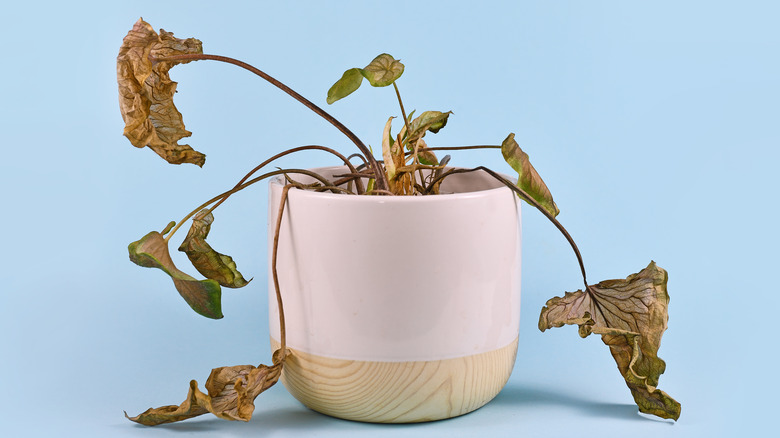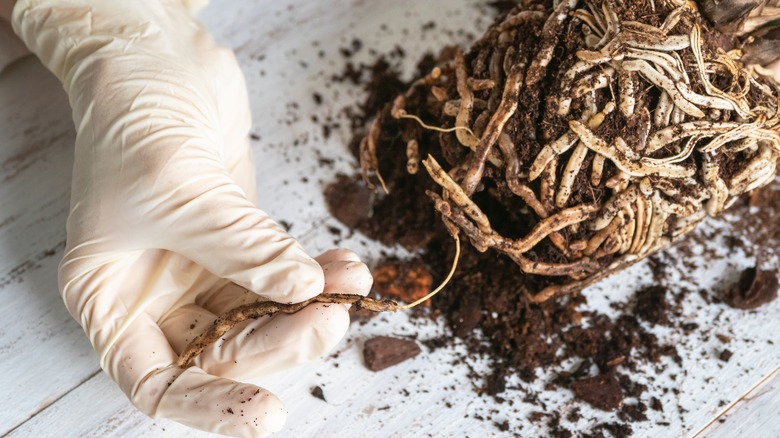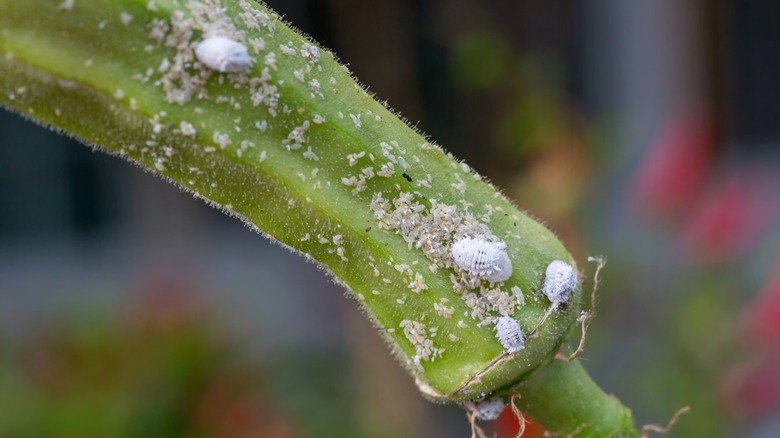5 Red Flags To Watch Out For When Purchasing Houseplants
One of the keys to houseplant success is starting with the healthiest plant possible. Sometimes this means choosing a thriving mature plant from which to take a cutting, divide a rhizome, or collect seeds when propagating new plants in the greenhouse. In the case of purchasing from a store, it's different because you don't know the plant's history. Generally speaking, specialized local nurseries are the best bet for high-quality seedlings and greenery, but the budget doesn't always allow for that kind of shopping experience. If you find yourself at a big box home improvement center or another similar store, you're going to want to inspect a plant from top to bottom before you whisk it away to its new life on the sill of your sunny south-facing window.
We all know that scientifically backed studies have proven the benefits of houseplants to our own health (via Healthline), yet how often do we stop to consider the health of our plants? Even if you've got your heart set on a specific variety and it's the last one left on the shelf, you'd be better off waiting until the store replenishes its stock or heading somewhere different to make your purchase. Sadly, a sick plant may be too far gone to revive. Bringing a diseased or infested plant into your home also puts your pre-existing houseplants at risk.
Ultimately, filling your house with plants should be an enjoyable experience. So let's get you started with your best foot forward.
Yellow leaves
Yellow leaves are a sure sign that a plant is under stress. Unfortunately, the problem is difficult to solve because it can stem from a number of conditions gone awry. Growers at Costa Farms lay out at least seven possibilities, the first of which is improper watering. Too much or too little water is the next question, however, you don't have a way of knowing; both overwatering and under-watering lead to yellow leaves.
From there, other potential issues include a lack of nutrition and light or a plant that has been stored at an inappropriate temperature. It's also possible that the leaves are dying off as a normal part of the overall plant's maturity, especially if it's the lowest level of leaves that are dropping.
The bottom line is that stress is the primary cause of yellowing leaves and it will likely take more work than is worth it to figure out the underlying issues without having any history. That said, a single yellow leaf on an otherwise healthy-looking plant is probably not a big deal. Similarly, Costa Farms notes that if a few leaves turn yellow after you get the plant home, it could simply mean that it's adjusting to its new surroundings. There's no need to jump to conclusions immediately, rather, keep it in its original grow pot and give it a week or two to settle in order to avoid further transplant shock from repotting.
Dark spots on leaves
If you see a plant for sale with dark spots on its leaves, there's a good chance it has a fungal infection. The Home & Garden Information Center at Clemson Cooperative Extension explains that there are many different species of fungi that can lead to this problem. Given the fact that their subscribed method of treatment is to destroy and discard any part of the plant that may be infected, it's in your best interest to not even get close to it. Bacteria can also cause leaf spots that come in tandem with sticky residue; again the course of treatment is to destroy and remove.
The reason for the destruction is that fungi and bacteria can survive and feed off of whatever dead or decaying leaves you've left behind. They'll stay there, feasting undetected, until they have a chance to reinfect the plant. Another problem with leaf spot diseases is that the infection can remain in the pot. Let's say you take a chance on a plant with a small infection trusting you'll be able to get it under control. If the plant doesn't make it, or even if it does and you end up repotting it, when you reuse that original container for a new plant or seedling, you may unintentionally pass along the disease.
Clemson Cooperative suggests deep cleaning and rinsing all grow pots and containers with a solution of water and bleach between every use.
Dry, brown leaves in wet soil
It's logical that leaf tips will begin to dry out and turn brown if the plant is not receiving enough water. If that's the case and the soil is bone dry, you've probably got an easy-to-solve riddle on your hands. But if the soil is dense with moisture, it's something else entirely. You may be wondering how it's possible for a plant to have dry, crispy, browning leaves if it's sitting in a pot full of oversaturated soil. Figuring out why it's not taking in water leads, quite literally, to the root of the problem. Pennington Seed points out that the issue is that the roots have been hindered from pulling up the water they need to spread around the plant.
Blocked drainage holes could be to blame. In theory, it's a simple fix to clear the holes and allow the plant to properly drain. If it's already been sitting in pooled water for a while, though, damage to the roots may have already begun. Far-gone root rot is a common, and unfortunately, devastating problem that can be impossible to turn around.
Per Pennington Seed, the leaf tips are the first to sustain injury because they're the farthest points from the roots and, therefore, the least likely to receive sufficient water when problems arise down below. Again, a brown-edged leaf or two may not be a big deal. Use your sharpest pair of scissors to cut away the brown parts.
An unhealthy root ball
The health of the root ball is so vital to a plant's survival that it's worth taking a peek at it regardless of whether the plant is showing visible signs of distress above the soil line. It's perfectly acceptable to gently slide a plant out of its grow pot to inspect what's happening below the surface.
No matter what type of plant you have, you'll recognize healthy roots as light in color (white or tan) and firm in feel, explains plant expert Amanda from Planterina (via YouTube). These main anchor roots and the fibrous feeder roots shooting out from them should remain intact upon investigation and be strong enough to endure some degree of handling. Brittle roots that break apart from the slightest touch are a sign of an unhealthy plant. The same is true for mushy roots that have turned gray or dark brown. Finally, roots that have repeatedly wound themselves around the root ball are becoming root-bound.
In addition to looking closely at the roots and touching them, you should also smell the root ball. It might feel like a silly thing to do in public, but it's worth the funny looks to find a plant you can love and tend to for years to come. Just think of yourself as the persistent old lady in the produce aisle tapping and sniffing for the perfectly ripe cantaloupe. Per Pennington Seed, the unpleasant scent of a rotting root system will be noticeable.
Tiny insects
According to the Home & Garden Information Center, the most important step in dealing with insects in regard to houseplants is to systematically take the precautions that prevent them from becoming a problem in the first place. Prevention being the key factor is really the only reason you need for passing on a garden center plant that shows any signs of an insect infestation. Also, keep in mind that a plant that's already under any of the other stressors we've discussed is going to be far more prone to problems with pests.
Aphids and spider mites are classified by the University of Missouri Extension as sucking pests. They manage their destruction by biting through stems and leaves and literally sucking out the plant's cellular makeup. They can often be controlled with power washes from the hose or insecticidal soaps, however, the question remains as to why you would want to bring these issues home from the store.
From the University of Maryland Extension, we get the lowdown on mealybugs; these are the tiny white insects shown in the photo above, which can be found covering any part of a plant or the container in which it comes. Because they're so small, they may seem insignificant at first glance, but these bugs can quickly multiply to become a large-scale infestation that wreaks havoc on your poor little houseplant. Furthermore, it's worth repeating that bringing an infected plant into your home invariably puts the others at risk.
